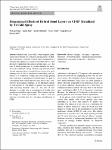Thông tin tài liệu
Thông tin siêu dữ liệu biểu ghi
| Trường DC | Giá trị | Ngôn ngữ |
|---|---|---|
| dc.contributor.author | Feng, Po-Lun | - |
| dc.contributor.author | Kim, Kinal | - |
| dc.contributor.author | Blassino, Adolfo | - |
| dc.date.accessioned | 2023-09-18T04:44:25Z | - |
| dc.date.available | 2023-09-18T04:44:25Z | - |
| dc.date.issued | 2023 | - |
| dc.identifier.uri | https://link.springer.com/article/10.1007/s11666-023-01638-7 | - |
| dc.identifier.uri | https://dlib.phenikaa-uni.edu.vn/handle/PNK/9069 | - |
| dc.description | CC-BY | vi |
| dc.description.abstract | Hybrid bond layers (BLs) were designed, fabricated, and evaluated for cold spray metallization of CFRP. The bond layers consisted of metal mesh embedded in a polymer film adhesive co-cured to the CFRP. Efforts were devoted to identifying the critical opening ratio—i.e., the ratio of mesh opening size to powder diameter, for deposition of an adherent coating. Analysis of powder deposited at mesh openings show a transition from erosion (at a mesh opening ratio of 6.4) to mechanical interlocking and formation of a continuous coating with decreasing opening ratio. Selection of opening ratio yielded either (a) a grid of consolidated thin-walled deposits atop mesh wires separated by microchannel openings, or (b) densified coatings of cold-sprayed Ti. The effective opening ratio increased with increasing diameter ratio—i.e., the ratio of wire diameter to powder size, a consequence of eroded wire peripheries at shallow impact angles. | vi |
| dc.language.iso | en | vi |
| dc.publisher | Springer | vi |
| dc.subject | Hybrid bond layers | vi |
| dc.title | Dimensional Effects of Hybrid Bond Layers on CFRP Metallized by Ti Cold Spray | vi |
| dc.type | Book | vi |
| Bộ sưu tập | ||
| OER - Khoa học Vật liệu, Ứng dụng | ||
Danh sách tệp tin đính kèm:

